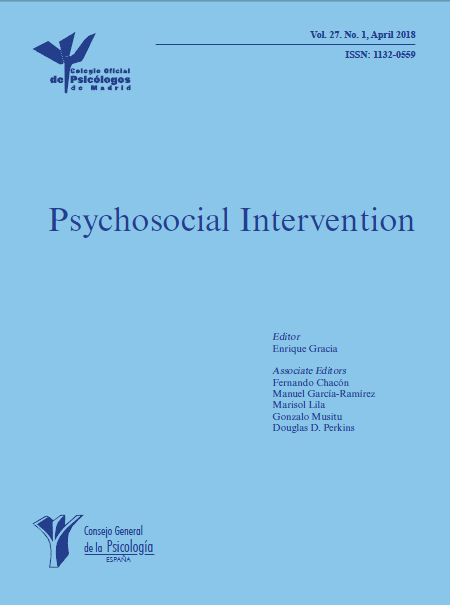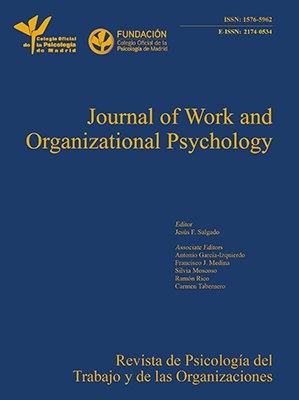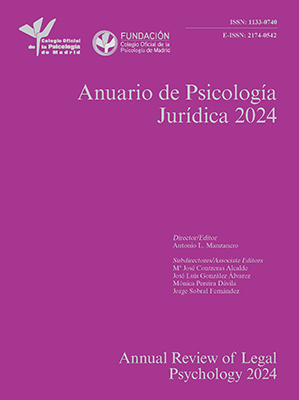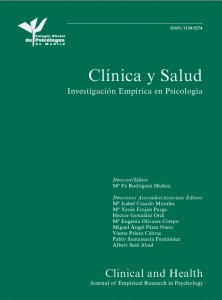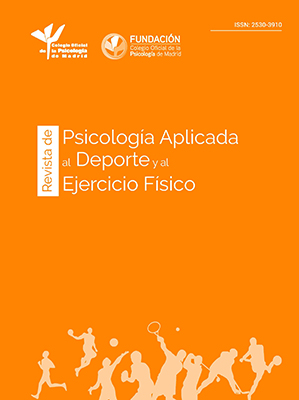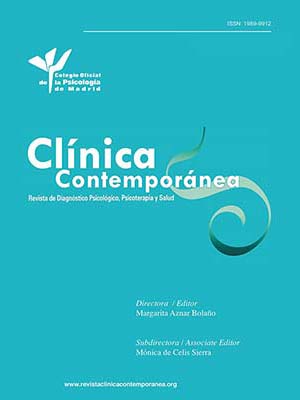
Adaptation and Preliminary Validation of the TRUST for Primary School Teachers (TRUST-PS)
[AdaptaciĂłn y validaciĂłn preliminar del TRUST para docentes de EducaciĂłn Primaria (TRUST-PS)]
Francesc Sidera1, Anna Amadó2, Clara Andrés-Roqueta3, Ana Górriz Plumed3, Georgina Perpiñà1, Eloy Soria-Izquierdo3, and Elisabet Serrat1
1Universitat de Girona, Spain; 2Universitat de Lleida, Spain; 3Universitat Jaume I, CastellĂł de la Plana, Spain
https://doi.org/10.5093/psed2025a8
Received 13 March 2024, Accepted 22 October 2024
Abstract
Teachers’ social and emotional competences (SEC) are important both for their well-being and for children’s development. Although there are self-report instruments that assess teachers’ SEC, only the TRUST assesses them directly through challenging secondary school classroom situations that teachers have to respond to. The aim of this research is to adapt it and validate it for primary school teachers, in Catalan language. A total of 143 teachers responded to a sociodemographic questionnaire, to an adaptation of the TRUST for primary school teachers (TRUST-PS), and to an emotional intelligence questionnaire (TEIQue-SF). The results revealed that the TRUST-PS has an adequate internal consistency for their two subtests: emotion regulation (α = .83) and relationship management (α = .87). Also, a two-factor model showed good fit to the data. In conclusion, the TRUST-PS can be used to directly assess primary school teachers’ SEC and be helpful for designing or evaluating teacher trainings.
Resumen
Las competencias sociales y emocionales de los maestros y maestras son importantes tanto para su bienestar como para el desarrollo de los niños y niñas. Aunque existen instrumentos de autoinforme que evalúan estas competencias en los docentes, solo el TRUST las evalúa directamente por medio de situaciones desafiantes en el aula de secundaria, a las que deben responder los profesores. El objetivo de esta investigación es adaptarlo y validarlo para docentes de primaria en lengua catalana. Un total de 143 docentes cumplimentaron un cuestionario sociodemográfico, una adaptación del TRUST para docentes de primaria (TRUST-PS) y un cuestionario de inteligencia emocional (TEIQue-SF). Los resultados revelaron que el TRUST-PS tiene una consistencia interna adecuada para sus dos subpruebas: regulación de las emociones (α = .83) y gestión de las relaciones (α = .87). Además, un modelo de dos factores mostró un buen ajuste a los datos. En conclusión, el TRUST-PS puede utilizarse para evaluar directamente las competencias sociales y emocionales de los docentes de primaria y ser útil para diseñar o evaluar la formación dirigida a estos profesionales.
Palabras clave
RegulaciĂłn de emociones, EducaciĂłn primaria, Competencias sociales y emocionales, Docentes, GestiĂłn de relacionesKeywords
Emotion regulation, Primary school, Social and emotional competences, Teachers, Relationships managementCite this article as: Sidera, F., Amadó, A., Andrés-Roqueta, C., Górriz Plumed, A., Perpiñà, G., Soria-Izquierdo, E., & Serrat, E. (2025). Adaptation and Preliminary Validation of the TRUST for Primary School Teachers (TRUST-PS). PsicologĂa Educativa, 31(1), 63 - 71. https://doi.org/10.5093/psed2025a8
Correspondence: francesc.sidera@udg.edu (F. Sidera).Social and Emotional Competences in Teachers There are multiple models, definitions, and concepts related to social and emotional competences (SEC). These diverse theoretical approaches include competences such as understanding one’s own and others’ emotions, emotional regulation and relationship management, responsible decision-making, setting and achieving goals, and feeling and showing concern and care, among others (Lozano-Peña et al., 2021). In this research, we will focus on the competences of emotional regulation and relationship management in primary education teachers. We have centered our attention to these competences because they are crucial in the school context, and they are related to the teachers’ well-being, to effective behavior management, and to the quality of teacher-students interactions, among others (Aldrup et al., 2020). Also, those competences are integrated into one of the latest frameworks for conceptualizing and evaluating socioemotional and behavioral skills (BESSI framework; Soto et al., 2022). This framework encompasses 32 facets organized into five domains: social engagement, cooperation, self-management, emotional resilience, and innovation. Emotional regulation refers to the conscious and unconscious processes used to influence emotions: what emotions we/others feel, when we/others feel them, how we/others feel them, and how we/others express them (Gross, 1998). However, there is not much agreement on whether emotional regulation refers to an intrinsic process (regulating one’s own emotions), an extrinsic process (regulating the emotions of others), or if it includes both dimensions. Despite recognizing the double dimensionality of emotional regulation (Gross, 2008), in this article we will focus on the intrinsic dimension of this process (that is, how teachers regulate their own emotions) as well as in the extrinsic dimension (how teachers manage the relationships with their students, which involves how they consider the emotions of the students). In this sense, some people have strategies to regulate their emotions, which can be useful for teachers in classroom situations, such as problem solving, cognitive restructuring, social and activity support, avoidance, suppression and rumination. Besides, the relationship management competence includes skills related to providing appropriate support to others, recognizing when people need support, conflict management, negotiation, and boundary setting, all of which are important for classroom management (Aldrup et al., 2020). Children’s cognitive and socio-emotional development is a process clearly influenced by the quantity and quality of the social interactions they experience, and the family and school are important contexts where they acquire and practice SEC. Therefore, teachers become referents, somewhat like attachment figures, whose attitudes, behaviors, and emotions, especially self-regulation, will shape those of the children in their classrooms from an early age (Mortensen & Barnett, 2015). Teachers have the co-responsibility to enhance children’s development in many aspects, including cognitive and academic competences as well as SEC (Alzahrani et al., 2019). In this respect, the importance of teachers’ SEC has been highlighted by researchers (Brackett & Katulak, 2006; Jennings & Greenberg, 2009). The results of several studies suggest that only emotionally competent teachers can contribute to educating children in an emotionally competent way (Ávila, 2019; Devis-Rozental et al., 2017; Extremera & Fernández-Berrocal, 2011). Teachers with good SEC can model them for the students, help students to manage stress and emotions to respond to different situations effectively and, ultimately, implement social and emotional learning (SEL) programs with fidelity and quality (Jones & Bouffard, 2012). In a similar vein, some studies have shown that teachers with a lack of emotional resources, or with emotional exhaustion, are less sensitive, and provide less emotional support to the students (Arens & Morin, 2016; Klusmann et al., 2016; Koenen et al., 2018). Teachers’ SEC are not only important for children’s development, but also for the teachers’ own well-being. Studies provide data on the increase in work absenteeism caused by psychological disorders among teachers (Yin, 2015), and indicate that their stress levels double or triple those of the general population (De Frutos et al., 2007). Research indicates that the main stressors for teachers are related to the social and emotional characteristics of teaching (Oliveira et al., 2021). In this sense, some studies link teachers’ SEC to a lower level of burnout (Donker et al., 2020; Torres-Hernández, 2018), to a better sense of self-efficacy (Conroy et al., 2019), and to better coping with the stressful events specific to the educational context (Cabello et al., 2010). Along the same lines, some educational programs based on teachers’ SEC show that these competences have significant effects on aspects such as stress, anxiety, well-being, job satisfaction and job commitment, relationships with the students, and classroom climate, among others (Montero Chicoma & Florentino Santisteban, 2023). Some authors argue that teachers and students of teaching studies must receive training in SEC and in how to develop them in students (Sepulveda-Ruiz et al., 2021), as this training generally does not currently exist beyond participation in SEL programs (Jones & Bouffard, 2012; Lozano-Peña et al., 2021; Schiepe-Tiska, et al., 2021). In a similar vein, Garcia-Vila et al. (2021) suggested that emotional education should be included in the design, development and evaluation of university training proposals. Some positive experiences indicate changes in this direction, such as a proposal to use writing as a tool for the regulation of emotions in undergraduate students of teaching during their school practices (Benito Ambrona et al., 2022). Apart from improving their training, teachers also need support in the development of their own SEC on a day-to-day basis, for example through networking and an organizational culture that encourages discussion, reflection, and teacher growth (Jones & Bouffard, 2012). Interventions aimed specifically at improving teachers’ SEC have increased in recent years. The meta-analysis carried out by Oliveira et al. (2021) shows that this type of intervention has a significant impact on reducing the burnout of preschool and primary school teachers, specifically in the dimensions of emotional exhaustion and reduced personal accomplishment (although no effect was found on the depersonalization dimension). Another conclusion of their meta-analysis was that the interventions aimed at improving the teachers’ SEC require working not only on their interpersonal skills (such as classroom management skills), but also on their intrapersonal ones (for example, regulating their emotions). In sum, being able to identify the social and emotional characteristics that help teachers to manage their own emotions and to establish positive relationships with their students becomes an important issue both for the development of the students and for the well-being of teachers (Aldrup et al., 2020). The Evaluation of SEC in Teachers: The TRUST Emotion is a highly complex process or phenomenon that is usually conceptualized as having several components: subjective, expressive, physiological, motivational, and cognitive (Schuman & Scherer, 2014). Buri et al. (2018) give a clear example of the combination of these components in angry teachers: they may feel bad (subjective component), change the tone of their voice (expressive component), experience a variation of their heart rate (physiological component), react by closing the classroom door (motivational component), and reflect on the students’ attitude (cognitive component). To fully capture the complex emotional experiences of teachers, attempts to measure them should address all or most of the described components (Buri et al., 2018). According to Pekrun and Bühner (2014), different strategies or procedures can be used to evaluate teachers’ emotions: observing expressive behaviour, neuroimaging the activation of emotion-related brain areas, obtaining physiological data or using a self-report methodology. Beyond the many risks involved in the use of self-reports in general psychological assessment, and for the assessment of SEC in teachers in particular, these authors suggest that this is not only the cheapest method but often the only one that can be applied. Also, unlike the other methods, it has the advantage of being able to assess all the emotion components. Several self-assessment questionnaires have been used to evaluate teachers’ SEC, such as the Trait Emotional Intelligence Questionnaire (TEIQue) (Petrides, 2009) or the Trait Meta-Mood Scale (TMMS) (Salovey et al., 1995). There is also at least one self-assessment instrument specifically created for evaluating the SEC of teachers and educators: The Self-Assessing Educator Social and Emotional Competencies and Instruction (Refreshed) (Yoder, 2022), However, to our knowledge, there are no tests that directly assess SEC and are designed specifically for primary school teachers. The Test of Regulation in and Understanding of Social Situations in Teaching (TRUST) is a test that has been developed to evaluate SEC of secondary school teachers. It is a situational judgement test that measures teachers’ knowledge of emotional regulation strategies and management of interpersonal relationships, through the proposal of various situations with students that represent an emotional and social challenge for teachers (Aldrup et al., 2020). The TRUST is thus a self-report test in which teachers are asked how they would behave in different classroom scenarios. The TRUST is similar to some tests aimed at the general population, such as the Mayer-Salovey-Caruso Emotional Intelligence Test (MSCEIT) (Mayer et al., 2002), but has the advantage of using specific knowledge of the teaching profession and of the norms of emotional expression in classroom contexts, knowledge that is necessary for teachers to have appropriate relationships with their students. The validity of the TRUST was assessed through three empirical studies with pre-service and in-service teachers, which showed that it reliably measured the socio-emotional competences of teachers (Aldrup et al., 2020). To our knowledge, the TRUST is the only instrument that directly measures the teacher’s SEC, but it currently exists only for secondary school teachers. Hence, the present study aims to adapt and validate the original TRUST for primary school teachers, which may have benefits both for research and for teacher trainings. This adaptation will be made in Catalan language. Participants A total of 143 primary school teachers participated in the study (118 woman and 25 men). Their mean age was 42.69 years (SD = 11.28, range 21 to 63). These teachers reported having worked a mean of 14.84 (SD = 10.936) years at primary schools (range = 1 to 42 years). Of the teachers, 121 had had experiences as tutors of a group of primary school students. Besides, we observed that the percentage of teachers who had experience in a given grade was similar for all grades (the range varied from 79 % of teachers with experience in second grade to 87.4 % of teachers with experience in sixth grade). In terms of language, 124 of the teachers (86.7%) reported having Catalan as a mother tongue. Among them, 31 reported having Spanish also as a mother tongue. Finally, 17 teachers reported having Spanish, not Catalan, as a mother tongue, and 2 teachers had neither of the two languages as a mother tongue. To ensure that there were no differences in the answers to the test depending on the mother tongue, we performed a group comparison with the Mann-Whitney U test between the participants who had Catalan as their mother tongue and those who did not. The analyses showed non-significant differences in any of the two factors of the test (p = .132 for Emotion Regulation; p = .626 for Relationship Management). Instruments Three instruments were administered online to the teachers. Sociodemographic Questionnaire A short questionnaire was administered to collect the following information from participants: age, sex and gender, number of years as a primary school teacher and as tutor, self-perceived socioeconomic level, training, and native language. Adaptation of the TRUST for Primary School Teachers (TRUST-PS) The TRUST (Aldrup et al., 2020) is a test in German that assesses secondary school teachers’ social and emotional skills using 17 classroom scenarios: 8 to assess skills related to the capacities of teachers to regulate their emotions (emotion regulation subtest) and 9 to evaluate the capacity of teachers to establish relationships with students (relationship management subtest). In each scenario, four possible teacher reactions are presented. Participants use a five-point scale (1 = very unhelpful, 2 = unhelpful, 3 = neutral, 4 = helpful and 5 = very helpful) to evaluate each of the possible reactions to regulate their emotions or to manage their relationships with the students. In terms of convergent validity, both subtests of the original version of the TRUST show positive and significant correlations with both the emotion management and emotional relations subtests of the MSCEIT (Mayer et al., 2002). The scoring of the TRUPST-PS kept the procedure of the original test (for an example of it, see the Appendix). All reactions within a scenario were first classified by the authors as very helpful, very unhelpful, helpful or unhelpful (following a theory-based coding scheme; see Aldrup et al. 2020). If a reaction was classified by the authors as very helpful (5), and participants chose the same response, they were awarded 1 point; 0.5 if they chose helpful (4).The same occurred for very unhelpful (1) reactions (participants were awarded 1 point if chose the same response, or 0.5 points if they judged the reactions as unhelpful). When a reaction was classified by the authors as helpful (4) or unhelpful (2), participants obtained points not according to their response in these reactions alone (what we call items in the manuscript), but also by comparing them with the reactions classified as very helpful (5) and very unhelpful (1) (we call them pairwise comparisons in this manuscript). For example, if a reaction was deemed to be helpful (4) by the authors, participants would score 1 point if they judged this reaction as less effective than very helpful (5) reactions (adjacent strategies), 0.5 points if they judged both reactions as equally helpful, and 0 points if the child responded in the opposite direction than expected. The same scoring applied when unhelpful reactions (2) were compared to very unhelpful (1) reactions. On the other hand, when responses to helpful (4) reactions were compared to responses to very unhelpful (1) reactions (distant strategies), participants scored if they realized that helpful reactions were better. Participants obtained 1 point if the difference in their responses was at least of +2, 0.5 points if the difference was of +1, and 0 otherwise. The same system applied when unhelpful (2) reactions were compared to very helpful (5) reactions. In this study, we adapted the original version of the TRUST to primary school teachers. We call to this version TRUST-PS. To do so, we departed from the original version translated into English (see Aldrup et al., 2020). In that version, one scenario was eliminated after the analyses, but this scenario was included in our process of adaptation to analyze its properties in the primary school context. Next, we will describe the process of adapting the instrument for primary school teachers and translating it into Catalan, a vehicular language of the regions of Spain in which the study was conducted (Valencian Community and Catalonia). The author of the original test was involved in this process, together with four authors of the present manuscript, and three primary school teachers. Although we tried to keep the instrument as similar to the original as possible, we needed to introduce some changes related to the cultural context of primary schools in Catalonia and the Valencian Community. First, we adapted the student grades described in the different scenario, reducing the ones described in the original scenario to four grades, or even more (for example, in some primary school grades children don’t usually do homework). In addition, in some scenarios where the teacher was described as a man, we changed the description to that of a woman, to better reflect the gender reality of the primary school teachers in our areas. Apart from these changes, we introduced some changes in the content of the scenario or in the description of the possible responses to the scenarios, to fit to the reality of primary schools in our regions. These changes were first made by the authors, leading to a preliminary version. Once we had this version, we contacted three primary school teachers to validate it. They were asked to assess the clarity of the wording (good vs. needs to improve, and in which aspects), as well as the adequacy of each of the scenario s and responses to them (good vs. needs to improve, and in which aspects). After their comments, a final version of the instrument was obtained. The changes finally made to the original version were related to the following aspects: a) differences between the secondary education system in Germany and the primary education system in Catalonia and the Valencian Community (for example, in our area there is no fall break, primary school teachers don’t have mentors, there are no academic tracks, and no liaison teachers); b) differences between secondary and primary school students (for example, we eliminated a reference to the student as an adolescent); c) differences in how parents might behave (for example, a parent in primary school in our area would probably want to talk to the teacher in person and not by phone about a possible bullying situation). An example of two scenarios of the TRUST-PS can be seen in the Appendix. Spanish Version of the Trait Emotional Intelligence Questionnaire Short Form- TEIQue-SF The TEIQue-SF is a 30-item questionnaire that assesses the emotional intelligence of adults on a Likert scale (ranging from 1 = strongly disagree to 7 = strongly agree). This tool was used to analyze the concurrent validity of the TRUST-PS. The short version of the test was created by Cooper and Petrides (2010), and the Spanish version, which we administered in the present study, was developed by Laborde et al. (2016). According to these authors, this version of the instrument presents high correlations between its four sub-scales (well-being, self-control, emotionality and sociability) and the corresponding scales of the long version of the instrument (TEIQue-LF; Petrides, 2009), as well as with the overall score. In addition, a confirmatory factor analysis supported the construct validity of the TEIQue-SF and the TEIQue-LF (Laborde et al., 2016). Procedure First, the evaluation instruments and a consent form at the beginning of the questionnaire were introduced onto a survey platform (MachForm). Then, an e-mail explaining the objectives of the study was sent to the management teams of all schools (both public and private) in Catalonia, and to all schools in Castellón (city in the Valencian Community). They were asked to send all their primary school teachers a PDF document explaining the study and providing a link to access the questionnaire. The questionnaire contained no data that would identify respondents and was entirely anonymous. The study was approved by the Research Ethics and Biosecurity Committee of the University of Girona (approval code: CEBRU0023). Data Analysis As a preliminary step, item-total correlations, item difficulties, and the reliability of the TRUST-PS were calculated using SPSS. Like in the development of the original test version, we selected a set of items that differentiated well between participants with higher and lower social-emotional competence. Therefore, items with item-total correlations of rit < .15 were excluded. We slightly eased this criterion for items that had performed well in the original test version and retained those with rit ≥ .10 in the adapted version. These comparably mild exclusion criteria were chosen because the broad nature of the measured constructs and the heterogeneity of the scenarios and reactions were likely to reduce inter-item correlations (Clark & Watson, 1995). Furthermore, we aimed to maintain a symmetric test structure with four potential reactions for each scenario. Lastly, item-total correlations are sample-dependent. Therefore, we wanted to avoid eliminating items that had already proven to differentiate well between participants simply because they were slightly below the criterion in our specific sample. Having selected a set of well-functioning items, we examined Cronbach’s α to check whether the reliability was acceptable. First, we investigated Cronbach’s α at the level of the individual items (points obtained by identifying the effective strategy in each possible reaction) and pairwise comparisons (points when participants differentiated better from worse strategies in the different possible reactions of a scenario). However, the pairwise comparisons lead to interdependencies among the items and pairwise comparisons within one scenario, which may result in an overestimation of Cronbach’s α. Therefore, we additionally calculated the mean score for each scenario and tested the reliability on the scenario level. Then, we tested the factor structure of the TRUST-PS applying confirmatory factor analyses in Mplus 7 (Muthén & Muthén, 1998-2012) using maximum likelihood estimation with robust standard errors. In all models, items were only allowed to load on the theoretically expected factor. Because of the large number of items and the relatively small sample size, we decided to reduce the number of parameters to be estimated by creating parcels in a first step. As for the more conservative estimation of Cronbach’s α, parcels were obtained by computing the mean score for each scenario (Little, 2013). To evaluate model fit, we considered Tucker-Lewis index (TLI) and confirmatory fit index (CFI) values ≥ .95, root mean square error of approximation (RMSEA) values ≤ .06, and standardized root mean square residual (SRMR) values ≤ .08 as indicative of good model fit (Hu & Bentler, 1999). Finally, we conducted correlation analyses to investigate the convergent validity of the TRUST-PS. Item Analyses and Item Selection As a preliminary step, we investigated the item difficulties (i.e., percentage of points obtained per item) to get a first impression of whether there was variability in teachers’ responses to the items (values in the following are based on the full set of items and pairwise comparisons and, therefore, do not fully correspond with Table 1). Item difficulties ranged from Pi = 23.08 to Pi = 93.71 for emotion regulation and from Pi = 17.83 to Pi = 88.81 for relationship management. On average, item difficulties were Pi = 70.20 in the emotion regulation subtest and Pi = 58.15 in the relationship management subtest. These values were comparable to the original German version (emotion regulation: 67.46 ≤ Pi ≤ 75.14; relationship management: 60.75 ≤ Pi ≤ 64.87). Hence, item difficulties were, overall, adequate and the TRUST-PS included items that were adequately answered by most respondents as well as items that were more difficult to score. Table 1 Item Difficulties, Item-Total Correlations, and Cronbach’s α for the TRUST-PS Subtests  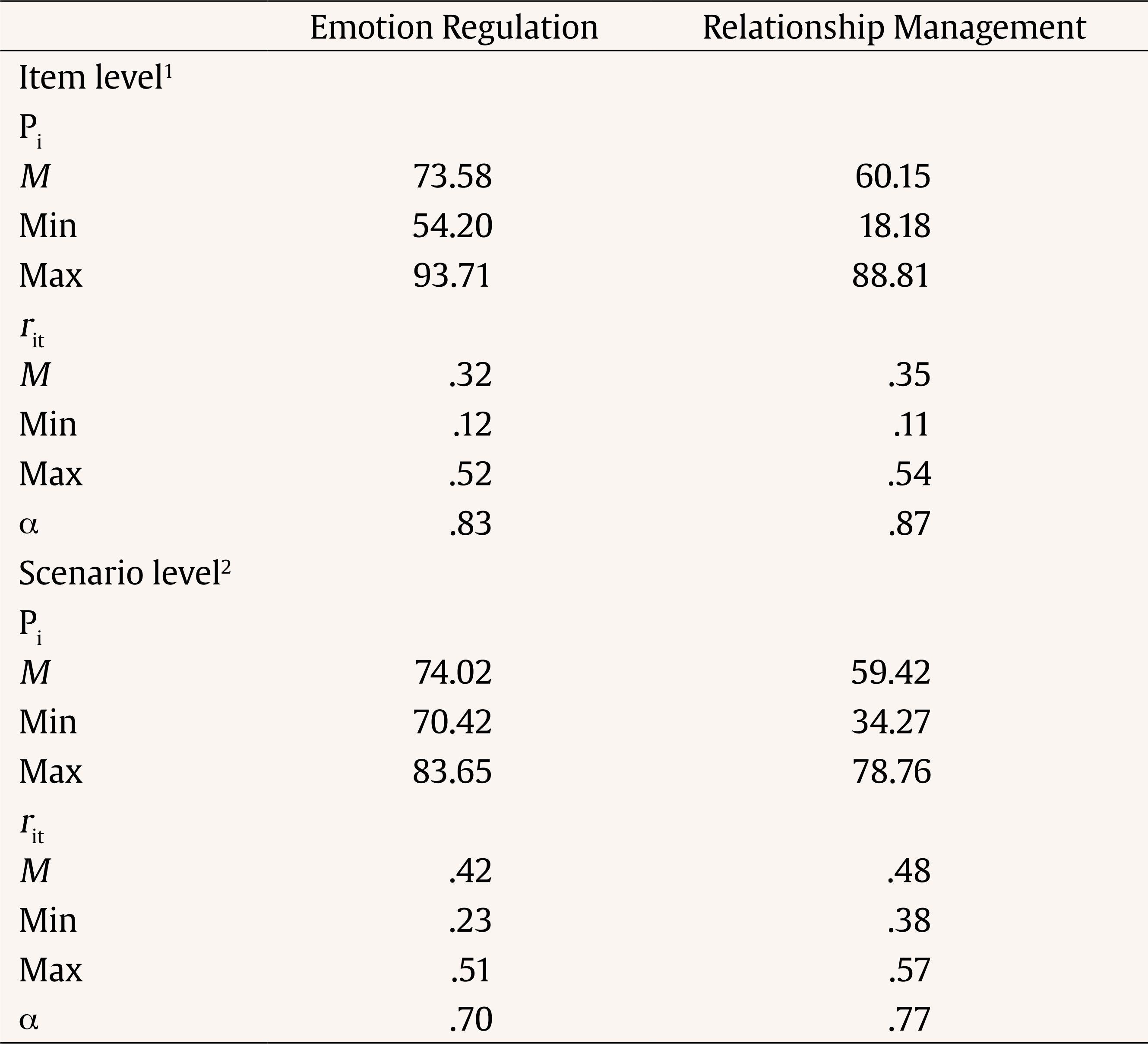 Note. 1Analyses based on 37 individual items/pairwise comparisons in the emotion regulation subtest and 41 individual items/pairwise comparisons in the relationship management subtest; 2analyses based on the mean for all items/ pairwise comparisons included in a scenario (emotion regulation: seven scenarios, relationship management: eight scenarios). In the next step, our goal was to check whether there were items that represented teachers’ SEC in terms of emotion regulation and relationship management only to a limited degree and should therefore be excluded. For this purpose, we examined the corrected item-total correlations for each item and pairwise comparison with the respective subtest. From all possible items and pairwise comparisons, we excluded five pairwise comparisons in the Emotion Regulation subtest, seven pairwise comparisons in the Relationship Management subtest, and one entire scenario in each subtest. As explained before, items (or pairwise comparisons) with item-total correlations of rit < .15 were excluded (in the case of items that performed well in the original test version, we retained those with rit ≥ .10). Specifically, for the Emotion Regulation subtest, a pairwise comparison was erased in scenario 1 (rit = .068), another one in scenario 5 (rit = .112), two in scenario 6 (rit = .075 and rit = .078) and one in scenario 7 (rit = .112). All item-total correlations for scenario 8 were below 0.15 so this scenario was not included. For the Relationships Management subtest, one pairwise comparison was eliminated in scenario 2 (rit = .015); one in scenario 3 (rit = .114), two in scenario 6 (rit = .069 and rit = -.78), one in scenario 7 (rit = .076), and two in scenario 8 (rit = .062 and rit = -.095); The whole scenario 1 of the Relationships Management subtest was excluded because one item and two pairwise comparisons had item-total correlations below .10. The final scenarios included four to six pairwise comparisons and items (the scores in the scenarios ranged from 4 to 6) and information from all of the four potential reactions was used for calculating the total score. There was large overlap between the original and the adapted version in the Emotion Regulation subtest: the adapted version included 32 of the 33 items and pairwise comparisons from the original version and five additional pairwise comparisons (comparison not included in the original version). Scenario 8 of this subtest was eliminated both in the German and Catalan versions. Therefore, a maximum of 37 points was possible in this subtest. In the Relationship Management subtest, seven of the nine scenarios performed similarly in both versions leading us to include 31 of the 34 items and pairwise comparisons from the original version and ten additional pairwise comparisons. However, unlike the original version, the TRUST-PS comprised the third, but not the first scenario of the Relationship Management subtest. A maximum of 41 points was possible in this subtest. Calculating the internal consistency based on the 37 items and pairwise comparisons in the emotion regulation subtest (α = .83) and the 41 items and pairwise comparisons in the relationship management subtest (α = .87) yielded good reliability. A more conservative estimation at the scenario level still yielded satisfactory reliability (seven emotion regulation scenarios: α = .70; eight relationship management scenarios: α = .77). Table 1 provides an overview of the item-total correlations, item difficulties, and reliabilities for the final test version. Internal Structure Validity Evidence We conducted confirmatory factor analyses to confirm that the scenarios from the two subtests reflected two underlying latent constructs like in the original version (i.e., emotion regulation and relationship management skills). The two-factor model showed good fit to the data (χ² = 102.42, df = 89, CFI = .97, TLI = .96, RMSEA = .03, SRMR = .07). As illustrated in Figure 1, standardized factor loadings ranged between .31 ≤ λ ≤ .69 (M = .54). Even though the latent correlation between the subtests was large (r = .62), the two-factor model was superior to a one-factor solution (χ² = 142.79, df = 90, CFI = .86, TLI = .84, RMSEA = .06, SRMR = .07; Δχ² = 40.37, Δdf = 1, p < .001). Figure 1 Standardized Factor Loadings and Factor Inter-correlation from the Two-factor Model in Confirmatory Factor Analysis.  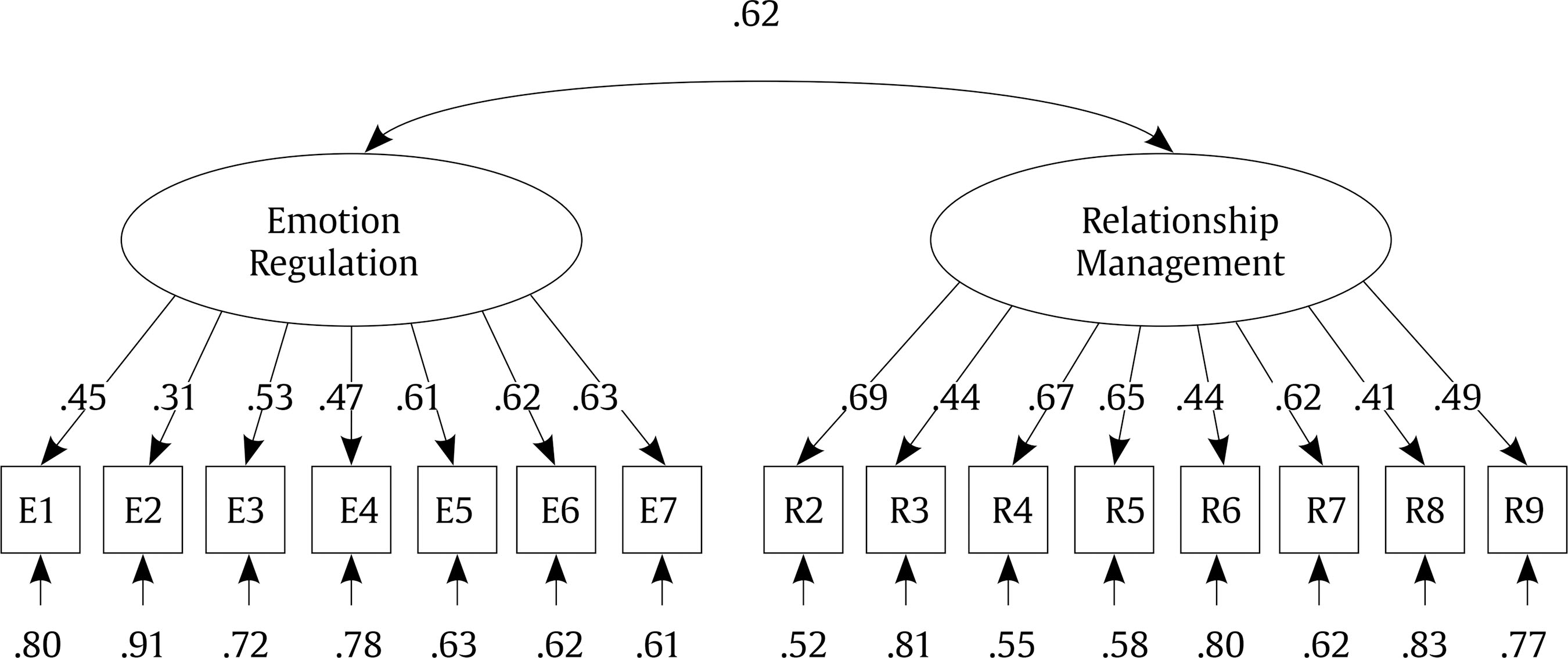 Note. E1-E7 = mean scores for the scenarios from the emotion regulation subtest (E8 was excluded), R2-R9 = mean scores for the scenarios from the relationship management subtest (R1 was excluded). Total Score: Distribution and Differences Based on Background Variables The satisfactory reliabilities for each subtest from the TRUST-PS and results from factor analyses supporting a two-factor solution allowed us to calculate total scores for each subtest. The total score for the emotion regulation subtest was on average M = 27.22 (theoretical maximum: 37 points) and M = 24.67 for the relationship management subtest (theoretical maximum: 41 points). Hence, our participants’ SEC was, on average, fair and somewhat higher regarding emotion regulation. The distribution of the total scores is illustrated in Figure 2. Female and male teachers did not differ regarding their average emotion regulation, t(141) = -1.49, p = .139, and relationship management scores, t(141) = -1.08, p = .280, and there was no correlation with teachers’ age (emotion regulation: r = .04, p = .653; relationship management: r = .07, p = .400). Figure 2 Distribution of the Total Scores in the Emotion Regulation (Upper-part) and Relationship Management (Lower-part) Subtests.  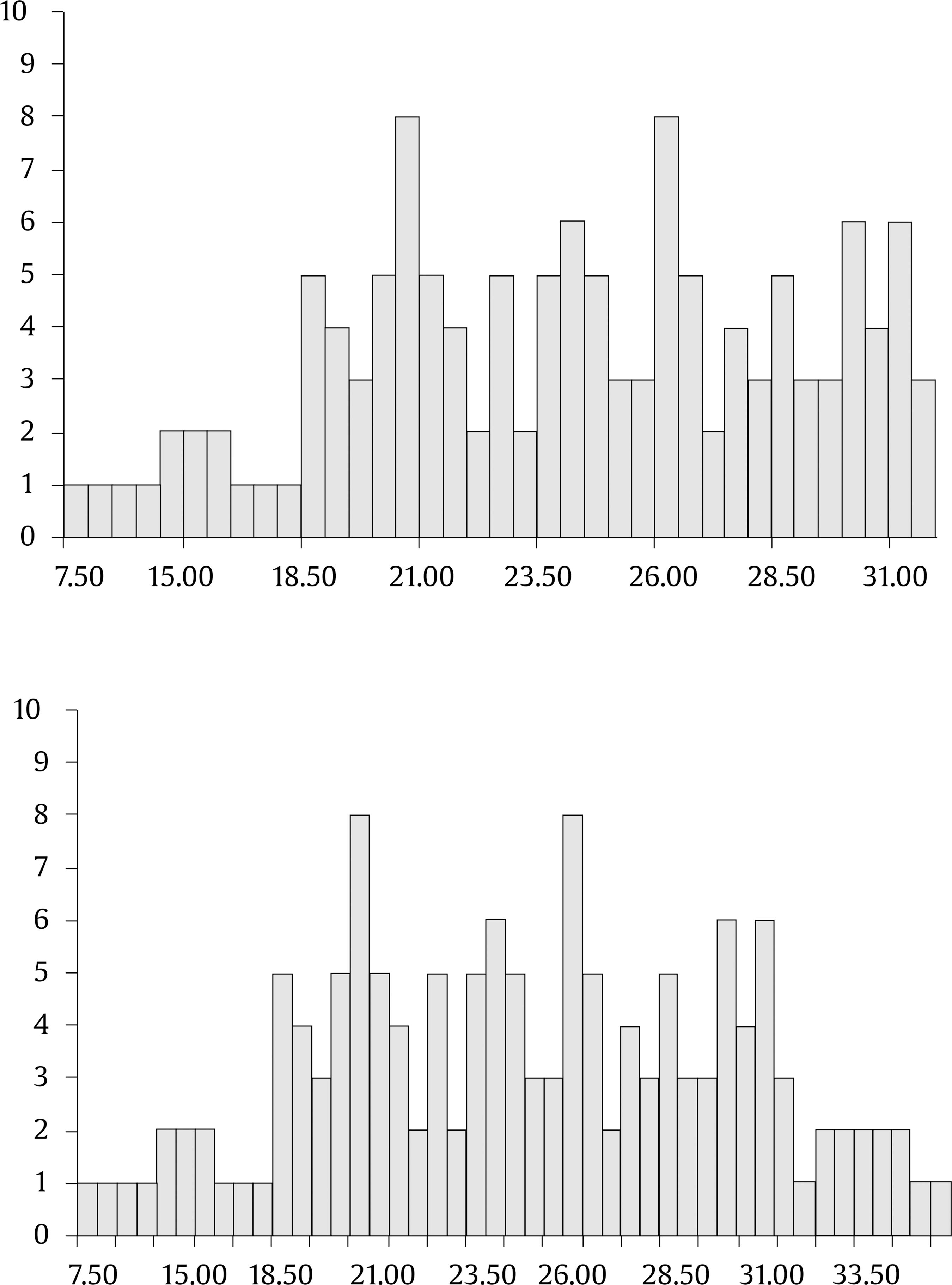 Convergent Validity We examined whether the TRUST-PS was positively associated with teachers’ emotional intelligence, more specifically, the facets of well-being, self-control, emotionality, and sociability as assessed with the TEIQue-SF. The mean score of this questionnaire for our sample was 5.34 (SD = .61). According to the norms of its manual (Petrides, 2009), this score is located between the percentile 50 and 60. As Table 2 displays, both TRUST-PS subtests showed small to moderate positive correlations with the TEIQue-SF total score as well as with some of its sub-scales. Of the TEIQue-SF sub-scales, well-being had the largest and statistically significant correlation with both emotion regulation (r = .32, p < .001) and relationship management (r = .24, p = .004). In addition, the emotion regulation subtest correlated statistically significantly with emotionality (r = .27, p = .001) and sociability (r = .24, p = .004), whereas the relationship management subtest yielded an association with self-control (r = .18, p = .032). Table 2 Convergent Validity: Correlation of the TRUST-PS Subtests with Emotional Intelligence   Note. See Cronbach’s alpha for TRUST-PS in Table 1. *p < .05, **p < .01. The main objective of this study was to adapt and validate the TRUST for a primary education context. Indeed, most tools designed to assess SEC are self-reported and not teacher specific. In this sense, this study contributes to the development of instruments for teachers that overcome the shortcomings of self-reported studies (such as the social desirability bias, the biases resulting from relating different measures of self -report, or the difficulties that people may have in evaluating the quality of their own interpersonal behavior) (Lozano-Peña et al., 2021; Montero Chicoma & Florentino Santisteban, 2023). Regarding the psychometric properties of the TRUST-PS, this instrument showed adequate internal consistency for both the emotion regulation subtest (α = .83) and for the relationship management subtest (α = .87), these being slightly lower when the analyses were carried out at the scenario level (α = .70 and α = .77, respectively). Regarding the internal structure validity evidence, despite finding a large latent correlation between the two subtests (r = .62), the two-factor model showed a better fit with the data than the one-factor model. Finally, regarding the convergent validity, we found positive and statistically significant correlations between the two subtests of the TRUST-PS and the overall score of the TEIQue-SF, as well as with some of its sub-scales, especially well-being, which correlated with the two TRUST-PS subtests. The well-being subtests of the TEIQUE-SF refers to a generalized sense of well-being to both the past and the future. In addition, it has been positively associated with aspects such as job satisfaction, and negatively with anxiety and depression (Petrides, 2009). So, these results are congruent with the studies mentioned above that highlight the importance of the teachers’ SEC for their well-being and provide convergent validity to the TRUST-PS. Despite the fact that the correlations between the TRUST-PS and the TEIQue-SF were significant, they were quite low. Here it needs to be considered that the TEIQue-SF is a self-report questionnaire of general emotional intelligence, and is possible that the TRUST-PS, which is a test that evaluates desired behaviors of teachers in the classroom, would show higher correlations with observational measures in the classroom. As a practical implication, having a global measure of teachers’ SEC and a subsequent training to enhance their skills may improve the conflict resolution skills required in the performance of teaching tasks, and consequently prevent possible emotional and behavioral alterations in the classroom, from aggressive behaviors, bullying situations or the prevention of substance use (Barrientos-Fernández et al., 2020; Cejudo & López-Delgado, 2017; Martínez-Pérez, 2023). Of course, our study has some limitations. First, convergent validity was measured only through self-reports, not through behavioral measures. Although the TRUST-PS is a direct measure of teachers’ SEC, and we found that it correlated with a self-report questionnaire, measures of how teachers behave in the classroom have not been used (for example, measuring the perception of other members of the educational community). In this regard, it would be interesting in the future to analyze to what extent the TRUST-PS is predictive of the teachers’ SEC in the classroom. Apart from that, the developed instrument considers some of the teachers’ SEC, but not others that have been proven to be also important (for example, responsible decision-making, cooperation or innovation). In this sense, in future studies, it would be interesting to use instruments that include these skills, such as the BESSI (Postigo et al., 2024; Soto et al., 2022), or develop other tests that have into consideration these competences. Finally, the present study has a relatively small sample, so future research should confirm the results obtained in this preliminary validation. The TRUST-PS has shown good psychometric properties, and therefore it represents an advance in the SEC literature since, to our knowledge, at present there are no instruments that directly measure these competences in primary school teachers. Thus, this tool can help assess the training needs of active and trainee teachers, as well as evaluate the effectiveness of SEC intervention programs for teachers. Adapting the instrument to other languages and educational contexts would allow wider use of the instrument. Conflict of Interest The authors of this article declare no conflict of interest. Acknowledgements We are very grateful to the directors and teachers who helped us to develop the TRUST-PS. We also appreciate the great help of Karen Aldrup, author of the original version of the TRUST, in developing this version of the instrument, as well as in analysing the data of the present manuscript. Cite this article as: Sidera, F., Amadó, A., Andrés-Roqueta, C., Górriz Plumed, A., Perpiñà, G., Soria-Izquierdo, E., Serrat, E. (2025). Adaptation and preliminary validation of the TRUST for Primary School Teachers (TRUST-PS). Psicología Educativa, 31(1), 63-71. https://doi.org/10.5093/psed2025a8 References Appendix Examples of Scenarios of the TRUST-PS (Translated into English) Example of Scenario from the Emotion Regulation Subtest: Mike is the tutor of a 5th grade class. Lately there have been more conflicts between his students and the mother of a child told him that she suspects her daughter, Helen, is being bullied. Mike doesn’t know how to deal with the situation. To what degree would the following reactions be helpful for Mike to feel better in the long run?
Explanation of the scoring in this scenario: Expected responses were marked in grey and example responses with “x”. The exemplary respondent would gain 0.5 points in the reaction a) because she underestimated its helpfulness, 1 point in reaction c) because she judged it adequately as very helpful, and 0 points in reaction d) because she judged it neutral whereas it was deemed as very unhelpful. On the other hand, points in reaction b) were awarded by comparing the responses of the exemplary respondent in this this reaction b) to her evaluations of reactions a, c and d. When comparing b) with a) (they are adjacent strategies, as they are both in the helpful side), 0.5 points were awarded, because the person adequately identified both as helpful, but not the whole point because the person should have judged reaction a) as more helpful. When comparing b) with c), the person obtained one point. When comparing b) with d) (they are distant strategies, as b is in the helpful side and ) in the unhelpful side), the respondent would have obtained 0.5 points, because the person evaluated both strategies with only 1 point of distance (+2 is necessary for obtaining the whole point), but in fact the person did not obtain any point because this pairwise comparison was excluded from the final test version due to a low item-total correlation. In sum, this scenario has 5 possible points, and the respondent obtained 3.5 points. Example of scenario from the Relationship Management subtest: Clara teaches maths to a group of 4th graders. One of her students is very behind, but she doesn’t seem to make any effort to improve her performance. To what degree would the following reactions be useful to motivate the student to learn and to maintain a good teacher-student relationship?
|
Cite this article as: Sidera, F., Amadó, A., Andrés-Roqueta, C., Górriz Plumed, A., Perpiñà, G., Soria-Izquierdo, E., & Serrat, E. (2025). Adaptation and Preliminary Validation of the TRUST for Primary School Teachers (TRUST-PS). PsicologĂa Educativa, 31(1), 63 - 71. https://doi.org/10.5093/psed2025a8
Correspondence: francesc.sidera@udg.edu (F. Sidera).Copyright © 2025. Colegio Oficial de la Psicología de Madrid








 e-PUB
e-PUB CrossRef
CrossRef JATS
JATS


